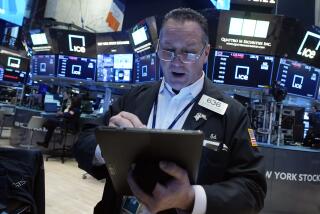Stocks fall, capping their worst quarter since 2008

- Share via
U.S. stocks fell Tuesday, closing out Wall Street’s worst quarter since the most harrowing days of the 2008 financial crisis.
The benchmark Standard & Poor’s 500 index dropped a final 1.6%, bringing its loss for the first three months of the year to 20%, as predictions for the looming recession caused by the coronavirus outbreak got even more dire. Stocks haven’t had this bad a quarter since the S&P 500 dropped 22.6% at the end of 2008 — the last time economists were talking about the worst downturn since the Great Depression.
The surge of coronavirus cases around the world has sent markets to breathtaking drops since mid-February, undercutting what had been a good start to the year. Earlier in the quarter, the major U.S. indexes climbed to record highs on expectations that the economy was accelerating because of calming trade wars and low interest rates around the world.
The price of benchmark U.S. crude oil dropped by roughly two-thirds this quarter on expectations that a weakened economy will need less fuel. The yield on the 10-year Treasury slid below 1% for the first time as investors scrambled for safety, and it ended the quarter at roughly 0.67%.
The big question is whether markets will get worse.
“People are trying to digest the length and magnitude of what the coronavirus impact is going to be,” said George Rusnak, managing director of investment strategy at Wells Fargo Private Bank.
The steep drops from Tokyo to Toronto in recent weeks reflect investors’ understanding that the economy and corporate profits are in for a sudden, debilitating drop. Economies around the world are grinding to near standstills as businesses close their doors and people hunker down at home in hopes of slowing the spread of the virus.
But markets have also cut their losses in recent weeks on hopes that massive aid from governments and central banks around the world can blunt the blow. The S&P 500 was down nearly 31% for the quarter at one point, but it has climbed 15.5% since March 23.
Among the next milestones for investors is Friday’s U.S. jobs report, which is expected to show a sharp drop in the number of people on payrolls. Companies will also begin reporting their first-quarter earnings results in upcoming weeks, and analysts expect the steepest drop in profits since the start of 2016, according to FactSet.
The numbers may get even worse in the following quarter. Goldman Sachs economists said Tuesday they expect the U.S. economy to shrink 34% in the second quarter, but they expect growth to rebound in the third quarter.
The S&P 500 fell 42.06 points to 2,584.59 on Tuesday. The Dow Jones industrial average declined 410.32 points, or 1.8%, to 21,917.16. The Nasdaq slid 74.05 points, or 1%, to 7,700.10.
The relatively modest moves are a big departure from the huge swings earlier in the month. On March 12, the S&P 500 sank 9.5% — its worst day since Black Monday 1987 — only to outdo itself with a 12% drop two trading days later. Sandwiched in between was a 9.3% surge.
Whether markets have indeed found a bottom or whether investors have become too optimistic about the economic rebound coming after the viral outbreak peaks is impossible to say without knowing when the coronavirus’ spread will begin to slow.
More to Read
Inside the business of entertainment
The Wide Shot brings you news, analysis and insights on everything from streaming wars to production — and what it all means for the future.
You may occasionally receive promotional content from the Los Angeles Times.










